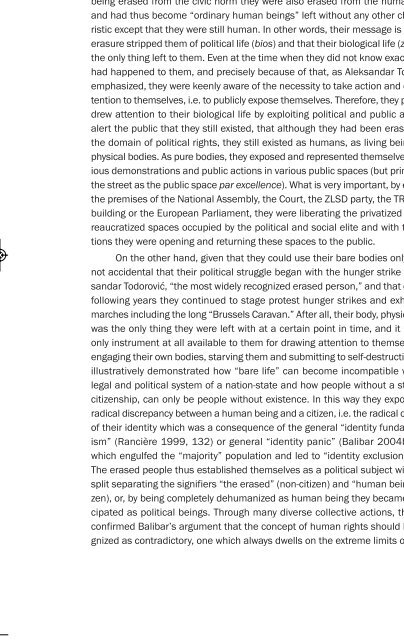The Scars of the Erasure_web
The Scars of the Erasure_web
The Scars of the Erasure_web
- No tags were found...
You also want an ePaper? Increase the reach of your titles
YUMPU automatically turns print PDFs into web optimized ePapers that Google loves.
<strong>Erasure</strong>_4a 10.1.11 20:29 Page 268268 THE SCARS OF THE ERASURE3. Emancipation as a process <strong>of</strong> shaping <strong>the</strong> political subjectWhat message did <strong>the</strong> erased people and <strong>the</strong>ir collaborators transmitthrough <strong>the</strong>se diverse actions? Primarily that <strong>the</strong>y understood perfectly that bybeing erased from <strong>the</strong> civic norm <strong>the</strong>y were also erased from <strong>the</strong> human normand had thus become “ordinary human beings” left without any o<strong>the</strong>r characte -ristic except that <strong>the</strong>y were still human. In o<strong>the</strong>r words, <strong>the</strong>ir message is that <strong>the</strong>erasure stripped <strong>the</strong>m <strong>of</strong> political life (bios) and that <strong>the</strong>ir biological life (zōē) was<strong>the</strong> only thing left to <strong>the</strong>m. Even at <strong>the</strong> time when <strong>the</strong>y did not know exactly whathad happened to <strong>the</strong>m, and precisely because <strong>of</strong> that, as Aleksandar Todorovićemphasized, <strong>the</strong>y were keenly aware <strong>of</strong> <strong>the</strong> necessity to take action and draw attentionto <strong>the</strong>mselves, i.e. to publicly expose <strong>the</strong>mselves. <strong>The</strong>refore, <strong>the</strong>y primarilydrew attention to <strong>the</strong>ir biological life by exploiting political and public action toalert <strong>the</strong> public that <strong>the</strong>y still existed, that although <strong>the</strong>y had been erased from<strong>the</strong> domain <strong>of</strong> political rights, <strong>the</strong>y still existed as humans, as living beings andphysical bodies. As pure bodies, <strong>the</strong>y exposed and represented <strong>the</strong>mselves in variousdemonstrations and public actions in various public spaces (but primarily in<strong>the</strong> street as <strong>the</strong> public space par excellence). What is very important, by entering<strong>the</strong> premises <strong>of</strong> <strong>the</strong> National Assembly, <strong>the</strong> Court, <strong>the</strong> ZLSD party, <strong>the</strong> TR3 <strong>of</strong>ficebuilding or <strong>the</strong> European Parliament, <strong>the</strong>y were liberating <strong>the</strong> privatized and bureaucratizedspaces occupied by <strong>the</strong> political and social elite and with <strong>the</strong>ir actions<strong>the</strong>y were opening and returning <strong>the</strong>se spaces to <strong>the</strong> public.On <strong>the</strong> o<strong>the</strong>r hand, given that <strong>the</strong>y could use <strong>the</strong>ir bare bodies only, it wasnot accidental that <strong>the</strong>ir political struggle began with <strong>the</strong> hunger strike by AleksandarTodorović, “<strong>the</strong> most widely recognized erased person,” and that over <strong>the</strong>following years <strong>the</strong>y continued to stage protest hunger strikes and exhaustingmarches including <strong>the</strong> long “Brussels Caravan.” After all, <strong>the</strong>ir body, physical bodywas <strong>the</strong> only thing <strong>the</strong>y were left with at a certain point in time, and it was <strong>the</strong>only instrument at all available to <strong>the</strong>m for drawing attention to <strong>the</strong>mselves. Byengaging <strong>the</strong>ir own bodies, starving <strong>the</strong>m and submitting to self-destruction, <strong>the</strong>yillustratively demonstrated how “bare life” can become incompatible with <strong>the</strong>legal and political system <strong>of</strong> a nation-state and how people without a state, i.e.citizenship, can only be people without existence. In this way <strong>the</strong>y exposed <strong>the</strong>radical discrepancy between a human being and a citizen, i.e. <strong>the</strong> radical cleavage<strong>of</strong> <strong>the</strong>ir identity which was a consequence <strong>of</strong> <strong>the</strong> general “identity fundamentalism”(Rancière 1999, 132) or general “identity panic” (Balibar 2004b, 182),which engulfed <strong>the</strong> “majority” population and led to “identity exclusion” (ibid.).<strong>The</strong> erased people thus established <strong>the</strong>mselves as a political subject within <strong>the</strong>split separating <strong>the</strong> signifiers “<strong>the</strong> erased” (non-citizen) and “human being” (citizen),or, by being completely dehumanized as human being <strong>the</strong>y became emancipatedas political beings. Through many diverse collective actions, <strong>the</strong>y alsoconfirmed Balibar’s argument that <strong>the</strong> concept <strong>of</strong> human rights should be reco -gnized as contradictory, one which always dwells on <strong>the</strong> extreme limits <strong>of</strong> demo -


